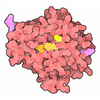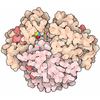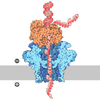+ Open data
Open data
- Basic information
Basic information
| Entry | Database: PDB / ID: 9k0d | ||||||
|---|---|---|---|---|---|---|---|
| Title | Cryo-EM structure of Amyloid-beta42-4b polymorph 1 | ||||||
 Components Components |
| ||||||
 Keywords Keywords | MEMBRANE PROTEIN / helical fibril / amyloid-beta / PROTEIN FIBRIL | ||||||
| Function / homology |  Function and homology information Function and homology informationamyloid-beta complex / growth cone lamellipodium / cellular response to norepinephrine stimulus / growth cone filopodium / microglia development / collateral sprouting in absence of injury / Formyl peptide receptors bind formyl peptides and many other ligands / axo-dendritic transport / regulation of Wnt signaling pathway / regulation of synapse structure or activity ...amyloid-beta complex / growth cone lamellipodium / cellular response to norepinephrine stimulus / growth cone filopodium / microglia development / collateral sprouting in absence of injury / Formyl peptide receptors bind formyl peptides and many other ligands / axo-dendritic transport / regulation of Wnt signaling pathway / regulation of synapse structure or activity / axon midline choice point recognition / astrocyte activation involved in immune response / NMDA selective glutamate receptor signaling pathway / regulation of spontaneous synaptic transmission / mating behavior / growth factor receptor binding / peptidase activator activity / Golgi-associated vesicle / PTB domain binding / positive regulation of amyloid fibril formation / Insertion of tail-anchored proteins into the endoplasmic reticulum membrane / Lysosome Vesicle Biogenesis / astrocyte projection / neuron remodeling / Deregulated CDK5 triggers multiple neurodegenerative pathways in Alzheimer's disease models / nuclear envelope lumen / dendrite development / positive regulation of protein metabolic process / TRAF6 mediated NF-kB activation / Advanced glycosylation endproduct receptor signaling / signaling receptor activator activity / negative regulation of long-term synaptic potentiation / modulation of excitatory postsynaptic potential / The NLRP3 inflammasome / main axon / transition metal ion binding / intracellular copper ion homeostasis / regulation of multicellular organism growth / ECM proteoglycans / regulation of presynapse assembly / positive regulation of T cell migration / neuronal dense core vesicle / Purinergic signaling in leishmaniasis infection / positive regulation of chemokine production / cellular response to manganese ion / Notch signaling pathway / clathrin-coated pit / extracellular matrix organization / neuron projection maintenance / Mitochondrial protein degradation / astrocyte activation / ionotropic glutamate receptor signaling pathway / positive regulation of calcium-mediated signaling / positive regulation of mitotic cell cycle / axonogenesis / protein serine/threonine kinase binding / response to interleukin-1 / platelet alpha granule lumen / cellular response to copper ion / cellular response to cAMP / positive regulation of glycolytic process / central nervous system development / endosome lumen / positive regulation of interleukin-1 beta production / dendritic shaft / trans-Golgi network membrane / positive regulation of long-term synaptic potentiation / adult locomotory behavior / learning / positive regulation of JNK cascade / Post-translational protein phosphorylation / locomotory behavior / serine-type endopeptidase inhibitor activity / microglial cell activation / positive regulation of non-canonical NF-kappaB signal transduction / TAK1-dependent IKK and NF-kappa-B activation / regulation of long-term neuronal synaptic plasticity / cellular response to nerve growth factor stimulus / recycling endosome / synapse organization / visual learning / response to lead ion / positive regulation of interleukin-6 production / Golgi lumen / cognition / Regulation of Insulin-like Growth Factor (IGF) transport and uptake by Insulin-like Growth Factor Binding Proteins (IGFBPs) / endocytosis / cellular response to amyloid-beta / neuron projection development / positive regulation of inflammatory response / positive regulation of tumor necrosis factor production / Platelet degranulation / heparin binding / regulation of translation / growth cone / regulation of gene expression / early endosome membrane / G alpha (i) signalling events / perikaryon / G alpha (q) signalling events Similarity search - Function | ||||||
| Biological species |  Homo sapiens (human) Homo sapiens (human) | ||||||
| Method | ELECTRON MICROSCOPY / helical reconstruction / cryo EM / Resolution: 2.6 Å | ||||||
 Authors Authors | Xia, W.C. / Sun, Y.P. / Liu, C. | ||||||
| Funding support | 1items
| ||||||
 Citation Citation |  Journal: Nat Commun / Year: 2025 Journal: Nat Commun / Year: 2025Title: An O-glycopeptide participates in the formation of distinct Aβ fibril structures and attenuates Aβ neurotoxicity. Authors: Qijia Wei / Dangliang Liu / Wencheng Xia / Fengzhang Wang / Lu Huang / Jun Zhang / Xiaoya Wang / Zhongxin Xu / Changdong He / Wenzhe Li / Xiaomeng Shi / Chu Wang / Yuan Liu / Cong Liu / Suwei Dong /  Abstract: The self-assembly of biomolecules through noncovalent interactions is critical in both physiological and pathological processes, as exemplified by the assembly of amyloid β peptide (Aβ) into ...The self-assembly of biomolecules through noncovalent interactions is critical in both physiological and pathological processes, as exemplified by the assembly of amyloid β peptide (Aβ) into oligomers or fibrils in Alzheimer's disease (AD). Developing molecules that can modulate this assembly process holds significant mechanistic and therapeutic potential. In this study, we identified glycopeptides as a class of protein aggregation modulators, showing that β-N-acetylgalactosamine (β-GalNAc)-modified Aβ promotes Aβ fibrillation while reducing its toxic oligomers. Using biochemical assays, cryo-EM, and molecular dynamics simulations, we demonstrated that β-GalNAc-modified Aβ coassembles with Aβ, forming unique fibril structures stabilized by both hydrophobic interactions and an organized hydrogen bond network facilitated by the glycopeptide. Importantly, β-GalNAc-modified Aβ can alleviate the neurotoxicity of Aβ in neuronal cells and an AD male mouse model. These findings underscore the potential of glycopeptides in regulating amyloid aggregation and provide structural insights for designing molecules targeting amyloid-related pathologies. | ||||||
| History |
|
- Structure visualization
Structure visualization
| Structure viewer | Molecule:  Molmil Molmil Jmol/JSmol Jmol/JSmol |
|---|
- Downloads & links
Downloads & links
- Download
Download
| PDBx/mmCIF format |  9k0d.cif.gz 9k0d.cif.gz | 73.4 KB | Display |  PDBx/mmCIF format PDBx/mmCIF format |
|---|---|---|---|---|
| PDB format |  pdb9k0d.ent.gz pdb9k0d.ent.gz | 55.8 KB | Display |  PDB format PDB format |
| PDBx/mmJSON format |  9k0d.json.gz 9k0d.json.gz | Tree view |  PDBx/mmJSON format PDBx/mmJSON format | |
| Others |  Other downloads Other downloads |
-Validation report
| Summary document |  9k0d_validation.pdf.gz 9k0d_validation.pdf.gz | 1 MB | Display |  wwPDB validaton report wwPDB validaton report |
|---|---|---|---|---|
| Full document |  9k0d_full_validation.pdf.gz 9k0d_full_validation.pdf.gz | 1 MB | Display | |
| Data in XML |  9k0d_validation.xml.gz 9k0d_validation.xml.gz | 28.9 KB | Display | |
| Data in CIF |  9k0d_validation.cif.gz 9k0d_validation.cif.gz | 41.7 KB | Display | |
| Arichive directory |  https://data.pdbj.org/pub/pdb/validation_reports/k0/9k0d https://data.pdbj.org/pub/pdb/validation_reports/k0/9k0d ftp://data.pdbj.org/pub/pdb/validation_reports/k0/9k0d ftp://data.pdbj.org/pub/pdb/validation_reports/k0/9k0d | HTTPS FTP |
-Related structure data
| Related structure data |  61944MC  9k0eC  9k0fC M: map data used to model this data C: citing same article ( |
|---|---|
| Similar structure data | Similarity search - Function & homology  F&H Search F&H Search |
- Links
Links
- Assembly
Assembly
| Deposited unit | 
|
|---|---|
| 1 |
|
- Components
Components
| #1: Protein/peptide | Mass: 4520.087 Da / Num. of mol.: 12 / Source method: obtained synthetically / Source: (synth.)  Homo sapiens (human) / References: UniProt: B4DMD5 Homo sapiens (human) / References: UniProt: B4DMD5#2: Protein/peptide | Mass: 1577.802 Da / Num. of mol.: 6 / Source method: obtained synthetically / Source: (synth.)  Homo sapiens (human) / References: UniProt: P05067 Homo sapiens (human) / References: UniProt: P05067#3: Water | ChemComp-HOH / | Has protein modification | N | |
|---|
-Experimental details
-Experiment
| Experiment | Method: ELECTRON MICROSCOPY |
|---|---|
| EM experiment | Aggregation state: FILAMENT / 3D reconstruction method: helical reconstruction |
- Sample preparation
Sample preparation
| Component | Name: Cryo-EM structure of Amyloid-beta42-4b polymorph 1 / Type: ORGANELLE OR CELLULAR COMPONENT / Entity ID: #1-#2 / Source: NATURAL |
|---|---|
| Source (natural) | Organism:  Homo sapiens (human) Homo sapiens (human) |
| Buffer solution | pH: 7.4 |
| Specimen | Embedding applied: NO / Shadowing applied: NO / Staining applied: NO / Vitrification applied: YES |
| Vitrification | Cryogen name: ETHANE |
- Electron microscopy imaging
Electron microscopy imaging
| Experimental equipment |  Model: Titan Krios / Image courtesy: FEI Company |
|---|---|
| Microscopy | Model: TFS KRIOS |
| Electron gun | Electron source:  FIELD EMISSION GUN / Accelerating voltage: 300 kV / Illumination mode: FLOOD BEAM FIELD EMISSION GUN / Accelerating voltage: 300 kV / Illumination mode: FLOOD BEAM |
| Electron lens | Mode: BRIGHT FIELD / Nominal defocus max: 2000 nm / Nominal defocus min: 1000 nm |
| Image recording | Electron dose: 55 e/Å2 / Film or detector model: GATAN K3 BIOCONTINUUM (6k x 4k) |
- Processing
Processing
| EM software | Name: PHENIX / Version: 1.15.2_3472: / Category: model refinement | ||||||||||||||||||||||||
|---|---|---|---|---|---|---|---|---|---|---|---|---|---|---|---|---|---|---|---|---|---|---|---|---|---|
| CTF correction | Type: NONE | ||||||||||||||||||||||||
| Helical symmerty | Angular rotation/subunit: 179.62 ° / Axial rise/subunit: 2.41 Å / Axial symmetry: C1 | ||||||||||||||||||||||||
| 3D reconstruction | Resolution: 2.6 Å / Resolution method: FSC 0.143 CUT-OFF / Num. of particles: 188636 / Symmetry type: HELICAL | ||||||||||||||||||||||||
| Refine LS restraints |
|
 Movie
Movie Controller
Controller






 PDBj
PDBj















